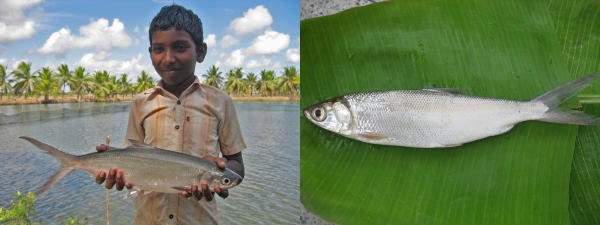New policies are needed to support small-scale fish farmers

Right: Milkfish in India. Photo: cc: Arun Padiyar/WorldFish on Flickr
A new journal paper makes several key recommendations to ensure poor producers share the benefits of India’s booming inland fisheries sector. [pullquote type=”pullquote5″ content=”India has made enormous progress in boosting the productivity of its inland fisheries” quote_icon=”yes” align=”right” textcolor=”#329a3e”]India has made enormous progress in boosting the productivity of its inland fisheries[/pullquote]
Researchers from the International Water Management Institute (IWMI) and the India Natural Resource Economics and Management (INREM) Foundation summarize a decade of research into the challenges faced by small-scale fish producers in the paper, Productivity and the poor? Political economy of village pond fishery in the Indo-Gangetic Basin, published in the journal, Water International.
After a 10-state survey involving hundreds of farmers, they found that policies to transform small-scale fish production into profitable commercial enterprises, while triggering a boom in fish production, had resulted in ‘elite capture’ – with richer fish farmers benefiting disproportionately. To address this, the authors recommend that smallholder fish farmers need better access to credit, new technologies, training and protection from poachers.
“India has made enormous progress in boosting the productivity of its inland fisheries,” said Tushaar Shah, Senior Fellow, IWMI, and lead author of the journal paper. “But only the farmers with access to finance, and those who are able to take risks and adopt new technologies have seen their livelihoods improve significantly. These tend to be the wealthier fish farmers. But now it’s time to try and ensure that the small-scale fish farmers can also gain from some of the new technologies and practices that have proven to be so successful.”
Viva la blue revolution?
For centuries, fishing in India was reserved for the lowest caste of society. Village ponds were shared resources, and competition between users was minimal due to low investments and low productivity. However, government efforts to introduce new technologies and intensify fish farming during the 1970s triggered a ‘blue revolution’. It transformed small-scale subsistence fishing into a vibrant commercial enterprise. Fish production increased sixfold between 1971 and 2005, and by 2010, fisheries contributed over USD 10 billion to India’s gross domestic product (GDP) and USD 3 billion to exports.
However, according to this new study, the majority of smallholder fish farmers, who make up around 75% of the industry, have not shared in this success. This is due to, for example, expensive setup costs and the rising price of pond leases, which have made it extremely difficult for small-scale fish farmers to compete with commercial fisheries. The authors found that the prices of pond leases had rocketed from USD 12-20/ha in 1996 to USD 1,100-2,200/ha in 2011 in two of the districts studied.
Additionally, where subsidies are offered to poor farmers to help them obtain pond leases, wealthier entrepreneurs often pay them to buy the leases on their behalf and provide them with a small share (10-15%) of the profits. The research study suggests that around a third of the village ponds are managed in this way. Corruption and rigged auctions for pond leases were also found to be a problem.
Poaching and ‘free-riding’ were flagged as major issues as well. Small-scale fish farmers have few incentives to intensify production, if the risk of losing fish is high.
So-called ‘revenge poaching’ is also a problem, where a competitor sabotages a rival’s pond. The paper says this can be easy to do: fish worth tens of thousands of dollars can be wiped out with a bottle of insecticide costing less than USD 2.
[pullquote type=”pullquote3″ content=”Poaching levels vary by region with the highest risk in northeastern states, where fish are sold to local markets and 80% of the population’s diet includes fish.” quote_icon=”yes” align=”center” textcolor=”#14a947″]Poaching levels vary by region with the highest risk in northeastern states, where fish are sold to local markets and 80% of the population’s diet includes fish.[/pullquote]
Some fish farmers respond to poaching by paying people to guard the ponds, but the most common strategy is giving away fish as gifts to community members, neighbors and potential poachers. However, this can be expensive: one small-scale fish farmer was expected to gift 40-50% of his catch.
In West Bengal, pond guards risk assault by poachers. To protect their livelihoods and safety, many fish farmers switched to selling 45-day-old fingerlings instead of larger ‘table fish’. Fingerlings are less profitable, but are harder to steal. Fish farmers sell the fingerlings to mastans (‘strong men’) who have the financial means to invest more in guards and can threaten, or retaliate against, poachers.
“While policies aimed at improving the livelihoods of small-scale fish farmers have been introduced,” continued Shah, “they still need better access to credit with low interest rates. This will enable them to purchase pond leases and invest in improving production. They also need scientific and technical support to intensify production and maximize profits. Most importantly, they need protection from fish theft, which can act as a disincentive to small farmers investing time and money in their ponds. Without these, it is unlikely they will see any change in their fortunes.”
[hr top=”yes”/]
Read the journal paper:
Shah, T.; Indu, R. 2014. Productivity and the poor? Political economy of village pond fishery in the Indo-Gangetic Basin. Water International 39(4): 563-576.
Tushaar Shah is a Senior Fellow at the International Water Management Institute (IWMI), Anand, India. Funding was provided by the IWMI-Tata Water Policy Program.

